education |
 |
|
 |
 |
 |
 |
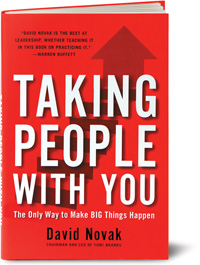
Taking People With You
Most good leaders know
that success is not an
individual achievement,
which is why J. Archie
Lyons, IV, global brand
marketing creative director
at Caterpillar Inc., picked
"Taking People With You."
Written by David Novak,
chairman and CEO of Yum!
Brands Inc. (owner of Taco
Bell, Pizza Hut, and KFC),
the book explains why, as
a leader, motivating the
people with whom you work
is paramount to accomplishing
your objectives.
What information in the
book resonated with you?
Success is dependent
on two criteria: your own
determination to succeed,
and the people you encounter
and partner with along
the way. Overall, the latter
probably has greater impact
on your life. As the author
writes, "You'll never accomplish
anything big if you try
to do it alone."
What differentiates "Taking
People With You" from
other business books?
The elements of the book
I find particularly helpful
are the insights from real
J. Archie Lyons, IV,
global brand
marketing creative
director, Caterpillar Inc.
business leaders. Novak,
himself the CEO of a huge
company, gathered input
from other business leaders,
so there's parity among the
different organizations. This
isn't a textbook without any
real relevance to what you
do everyday. You can see
the tangible connection to
real life, and I think that's
missing from most business
books out there today.
Speaking of tangible
connections, what makes
this a good read for
exhibit marketers?
In the world of exhibits, we
have to rely on a lot of other
people, including show
management personnel,
transportation carriers,
internal stakeholders, union
labor, etc. If we don't bring
those people along with
us and show them our
vision for what we want to
accomplish, we end up
spending most of our time
putting out fires. In the
end, we do twice as much
work to make that vision
happen. I've learned how
to step back and look at the
situation and determine a
way to restate my vision so
my team members get on
board in a positive way. It's
creating a shared experience
that bonds people
and helps them feel appreciated.
In the end, you
must get their involvement
to have their commitment.
|
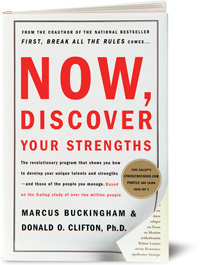
Now, Discover Your Strengths
This book, added to the
Summer Reading List by
Tim Naegelin, CME, senior
trade show associate at
Abbott Vascular, helps
readers identify their
talents and build them into
strengths. It focuses on
finding the hidden strengths
of people and exploiting
them, rather than finding
weaknesses and trying to
improve them.
What prompted you to add
this book to the list?
This book has given me the
encouragement and support
to really dive further into
my strengths and talents. I
spend too much time trying
to figure out what I need to
learn to get rid of my weaknesses
and not enough time
building on what I'm good
at. Doing that has given me
renewed passion for my job.
If you had to use one example
to illustrate the author's
theory, what would it be?
There is a story about a
man named Mike who had
a horrible stammer. He had
severe angst about talking
to people, and he was
constantly teased. When
he graduated boarding
school, he was forced to
read a passage to the entire
class. When he stepped up
to the podium and began,
everything flowed out effortlessly.
He discovered that
he liked being on stage in
front of a group of people.
It actually relaxed him, and
his brain could work more
easily. So rather than trying
to fix the weakness of his
stammer, he found that using
his strength of speaking
in front of a large group
helped him overcome it.
We live in a society where
weakness is frowned upon,
but not everyone can be
excellent at everything. How
does the book teach you to
focus on your strengths?
Almost from the get go,
the book reinforces that
you don't need to find the
weaknesses within yourself
and fix them, but rather
find the strengths and build
on them. Once you identify
those strengths and talents,
determine how they fit into
your life. In our jobs, we're
often told what our areas
of improvement are, rather
than being applauded for
our strengths and making
them better. Filling in the
gap of a weakness will help
you some, but if you don't
have the underlying talent
in that particular area, it
won't necessarily build you
into a better performer.
|
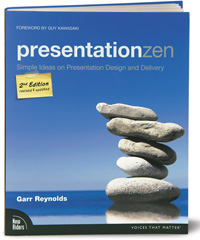
Presentation Zen
It's safe to say that nearly
everyone has sat through a
boring PowerPoint presentation
(or 10) in his or her
professional life. "Presentation
Zen," recommended by
Steven Marchese, CTSM,
manager of corporate
events at Fujifilm Medical
Systems USA, is a primer
on how to avoid "death by
PowerPoint" syndrome.
PowerPoint has been around
for 20 years, and yet it's
still a mainstay even in
this digital age. Are people
using it differently today?
Being able to communicate
ideas and concepts in these
tech savvy times creates
the need for presentations
to take a new approach
that is dynamic and visually
appealing. Corporate
presentations need to move
away from being a recitation
of bullet points to more of
a dynamic, interactive, and
emotional experience for
the audience.
So presentations need more
pictures, but fewer words?
That's certainly part of it.
Using the principles of Zen
philosophy, including the
"less is more" cliché, the
book's author, Garr Reynolds,
describes the virtue
of replacing content-laden,
bullet-pointed presentations
with visually stimulating images
and minimal text. His
presentation Zen approach
relies on storytelling and
audience engagement, ultimately
raising the quality of
professional speaking.
That approach might
intimidate people who aren't
comfortable presenting in
front of a group to begin
with. Does the book explain
how to become a better
speaker in general?
It helped me improve my
presentation skills, and I
learned that all graphics -
regardless of the medium
- should be simple, concise,
and engaging. The
book is divided into four
distinct sections: Preparation,
Design, Delivery, and
Next Steps, each of which
is followed by an "in sum"
end page that reviews the
principles outlined in that
section. Each section also
includes real-world speech
examples, and the second
edition is updated with
important lessons that all
presenters can learn from
Steve Jobs' legacy. My
"aha" moment is that the
best presentations have an
emotional, intimate, and
storytelling aspect to them.
That's now what I strive to
achieve when I present.
|

Poke the Box
According to Bonalyn
Boyd, creative director of
B-Creative Solutions, "Poke
the Box" by Seth Godin
will inspire readers to be
the source of innovation
and creativity for others.
"It might mean risks and it
might mean failure," she
says, "but it will be anything
but stagnant, and it will
create momentum in your
life toward achieving something
spectacular."
What led you to pick up
and read, "Poke the Box"?
I am a fan of Seth Godin's
books. I don't always have
the time to sit and read
the encyclopedias of best
business practices, but
Godin's books are small
and they are packed with
ideas, and truly motivate
me to change the world.
This just happened to be
the next one on my list.
If you had to identify the most
inspirational anecdote in
this book, what would it be?
There is a great little story
about Woodie the dog who
wears a shock collar for
protection within the area
of his invisible fence. He
learned - the hard way
- that crossing the border
would result in a rather
unpleasant feeling. At some
point, the invisible-fence
system stopped working,
but poor Woodie was too
afraid to push the boundary.
The boundary is in his
head, not in the system. It's
time to remove your shock
collar. Companies need
innovation. They need thrill
seekers. They need you to
bring them back to life and
take them to greatness. What do you think exhibit
managers can learn from
reading the book?
If you read EXHIBITOR, you
are probably a dreamer,
someone who loves being
inspired and inspiring
others. Remember when
you dreamed dreams, or
thought that you could make
a ramp with a board on
a soda bottle, and if you
went fast enough on your
skateboard, you could jump
over a car? You failed. But
you adjusted the ramp,
the calculations, and the
height of the object over
which you would jump.
You didn't give up. Your
friends bragged about you
at school. They even called
you crazy! But you did it.
I say, do that again. This
book will inspire you to
move, to see failure as a
gift because it means you
are that much closer to
achieving greatness.
|
 J. Archie Lyons, IV, J. Archie Lyons, IV,
global brand marketing creative director, Caterpillar Inc.
|
 Tim Naegelin, Tim Naegelin,
CME, senior trade show associate, Abbott Vascular |
 Steven Marchese, Steven Marchese,
CTSM, manager, corporate events, Fujifilm Medical Systems USA |
 Bonalyn Boyd, Bonalyn Boyd,
creative director,
B-Creative Solutions |
| |
|
|
|
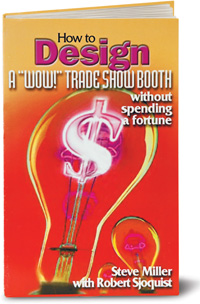
How to Design a "WOW!"
Trade Show Booth
Recommended by Lucy
Albert, CTSM, exhibit
coordinator at the Space
Telescope Science Institute,
this book offers the basics
of designing a straightforward,
effective exhibit on a
budget. Filled with practical
tips and information, it's
a small book packed with
the fundamentals of good
booth design.
Have you used this book
to help aid you in the
exhibit-build process?
Absolutely! I used it as a
guide when I was tasked
with developing a new
booth to showcase the
Hubble Space Telescope
at our science and education
conferences. I found
its practical information
extremely helpful, and I
was able to make realistic
decisions that ultimately
resulted in acquiring a
really great booth. I've used
it for smaller booths, too.
Is it fair to say this is a good
book for exhibit managers
with small budgets?
Definitely. Our academic
organization is nonprofit,
totally funded by the
Lucy Albert,
CTSM, exhibit
coordinator, Space
Telescope Science Institute
National Aeronautics and
Space Administration
(NASA), and as such, we
stay financially conservative
and quite reserved with our
exhibits. I had just been
given the task of creating
a brand new booth for
Hubble and, in the very
first chapter of the book, I
found the information and
ammunition I needed to
convince my superiors that
an attractive, well-designed
backdrop would be an asset
to enhance our presence on
the show floor.
It's not often that you're
able to put what you've read
into action so quickly and
effectively. How much of the
book's value is tied back to
the way it was written?
The ideas are presented
forthrightly and simply,
without tons of useless
verbiage. None of us have
time to go through major
tomes, and having the ideas
presented succinctly is
priceless. The book taught
me how to present my ideas
about a new booth in a
systematic and reasonable
way, and as a result, our institute
acquired a new exhibit
that has undergone many
incarnations for different
venues over the past several
years. What's more, I used
this experience in my CTSM
portfolio - so I credit the
book with helping me get
my certification.
|

Who Moved My Cheese?
An oldie but a goodie,
"Who Moved My Cheese?"
was added to the list by
Dominique J. Cook, CTSM,
trade show coordinator
for Marvin Windows and
Doors. The book follows
four main characters (two
mice and two small people)
as they work their way
through a maze toward
a piece of cheese - a
metaphor for navigating
the corporate world.
Mice, tiny people, cheese,
and a maze - this sounds
more like a J.R.R. Tolkien
novel than a business book.
Yes, there are mice, but
rest assured it's about more
than a maze and some
cheese. It's really about
learning how to adapt to
changes in your environment.
It teaches you that
those willing to adapt end
up gaining the most -
i.e., the cheese - while
those unwilling to change
often get left behind. I've
watched so many people
actually work hard to not
adapt (due to fear of the
unknown, sheer stubbornness,
and so on) when
things change both in their
Dominique J. Cook,
CTSM, trade show
coordinator, Marvin
Windows and Doors
personal and professional
lives. I think this simple
book could help provide
some clarity for people who
face similar challenges.
So it's kind of like one of
Aesop's Fables, but for the
corporate world?
I suppose you can look at it
that way. It definitely has a
life-lesson component. And
in fact, if I were managing a
team, I would want my staff
to read this book. With the
current state of the economy,
nothing remains the
same for long. Everyone
has to adapt almost daily.
This book shows that if you
are not willing to change,
you will be left behind.
And you can't rely on your
friends to lead you down
the correct path. You need
to figure it out on your own.
How has the book helped
you do your job?
I admit I was scared of
change when I first became
an exhibit manager.
But I took an amazing
project-management class
in grad school, and this
book happened to be required
reading. I learned
not to be afraid of change
but rather to embrace it.
Now, when I have to make
the decisions that I know
are scary, I'm not afraid to
pull the trigger because I
know it will ultimately lead
me to more cheese - well,
not literally.
|
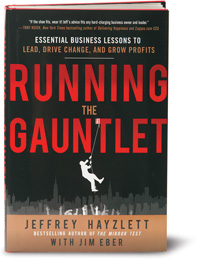
Running the Gauntlet
"Running the Gauntlet," added to the list by Holly Seese, global marketing communications manager at Celanese Corp., is an entertaining read about change management and how it can propel a business to the next level. Seese points out that all too often, companies languish because they are stuck in their same old way of doing things. "You need to be a change agent to wake up a company and help it to see real potential in the future," she says.
What is the single most
important lesson you learned by reading the book?
At one point in the book, the author, Jeffrey Hayzlett, recommends making an informed decision, but to make it quickly. Paralysis by leaders, even when the writing is on the wall, is the demise of many great companies. There's also a section in the book that talks about realizing that you might do the right thing, or you might do the wrong thing in a particular situation, but in the end, it's highly unlikely that anyone is going die because of it - unless of course you're a doctor or something. I think that's a good and applicable takeaway for exhibit and event managers.
It's easy for CEOs and
presidents to make decisions that lead to sweeping changes - they're in charge, after all. So how do you affect change if you don't hold a position of leadership within your own company?
The book urges readers to be the change agents in their own companies, regardless of whether or not they're in the C-suite. So if you want something changed, sometimes you have to do it yourself. That's a valuable lesson for everyone - be the change you want to see. I think Gandhi said that.
Indeed. Would you say the book has helped you grow in your role as an exhibit-marketing professional?
I think I push for resolution a little bit faster instead of over-thinking every little detail. I learned to put my effort in the areas where it is needed most. Also, reading the book has helped me challenge some of my own internal processes, and the lessons I learned from it have enabled me to streamline things in my exhibit-marketing program.
|
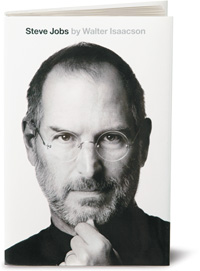
Steve Jobs
It's no surprise that "Steve Jobs" by Walter Isaacson contains anecdotes that reach far beyond the realm of technology and electronics. Aside from being a true Silicon Valley visionary, Jobs was an astute businessman, which is why John Zeltin, manager of event marketing for American Express Co., added the biography to the list and urges exhibit and event managers to read it.
We all know Steve Jobs,
who passed away late last year, as the genius behind tech wonders such as the iPad and iPhone. But while reading the book, what surprised you most about the man in the black turtleneck?
The book was authorized by Jobs himself, and it's obvious it was carefully researched. The result is a very frank description of a man that many of us only knew as the guy who founded Apple Inc. It's a great and fascinating study of a real visionary and genius. At the same time, Isaacson writes that Jobs was very difficult to work with, and especially hard on those closest to him.
So the book taught you how to work with "visionaries" (aka difficult people)?
We all work with people that we don't quite understand, to put it diplomatically, and learning to make the most of professional relationships is obviously important, especially for exhibit and event marketers. Reading how this man started Apple, was forced out, and then returned to lead it back from the ashes is really quite amazing. In the book, Isaacson reports that Jobs always wanted to work with "A performers" and wanted nothing less than perfection.
I guess that pursuit of perfection is why people labeled him as being quite difficult to work with.
What makes it a must-read for exhibit managers?
I think it's a must-read for everyone, not just exhibit managers. Apple changed the way we work, and the book takes you through the evolution of technology in Silicon Valley. It's very interesting stuff, and in fact, the main idea I took away from it is that you can accomplish amazing things if you have a laser-like focus and a constant dedication to deliver the best work possible. I think that's something we can all take to heart.
|
 Lucy Albert, Lucy Albert,
CTSM, exhibit coordinator, Space Telescope Science Institute
|
 Dominique J. Cook, Dominique J. Cook,
CTSM, trade show coordinator, Marvin
Windows and Doors |
 Holly Seese, Holly Seese,
global marketing communications
manager, Celanese Corp. |
 John Zeltin, John Zeltin,
manager, event marketing,
American Express Co. |
|
|








 J. Archie Lyons, IV,
J. Archie Lyons, IV, Tim Naegelin,
Tim Naegelin, Steven Marchese,
Steven Marchese, Bonalyn Boyd,
Bonalyn Boyd,



 Lucy Albert,
Lucy Albert, Dominique J. Cook,
Dominique J. Cook, Holly Seese,
Holly Seese, John Zeltin,
John Zeltin,


